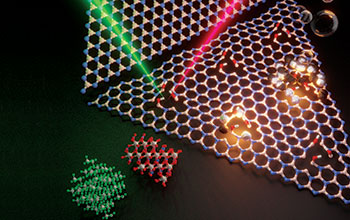Multimedia Gallery
Defects in a lattice structure of hexagonal boron nitride can be detected with photoluminescence
Defects in a lattice structure of hexagonal boron nitride can be detected with photoluminescence. Researchers shine a light with a color or energy on the material and get a different color from the defect. In addition, the figure shows hydrogen bubbles being generated from these defects that contain catalyst atoms (gray and dark spheres attached to the vacancies).
[Research supported by U.S. National Science Foundation grant HRD 2137557.]
Learn more in PennState news story Can defects turn inert materials into useful, active ones?. (Date of image: Nov. 18, 2021; date originally posted to NSF Multimedia Gallery: Nov. 6, 2022)
Credit: Elizabeth Flores-Gomez Murray, Yu Lei and Kazunori Fujisawa,
Images and other media in the National Science Foundation Multimedia Gallery are available for use in print and electronic material by NSF employees, members of the media, university staff, teachers and the general public. All media in the gallery are intended for personal, educational and nonprofit/non-commercial use only.
Images credited to the National Science Foundation, a federal agency, are in the public domain. The images were created by employees of the United States Government as part of their official duties or prepared by contractors as "works for hire" for NSF. You may freely use NSF-credited images and, at your discretion, credit NSF with a "Courtesy: National Science Foundation" notation.
Additional information about general usage can be found in Conditions.
Also Available:
Download the high-resolution JPG version of the image. (5.6 MB)
Use your mouse to right-click (Mac users may need to Ctrl-click) the link above and choose the option that will save the file or target to your computer.



